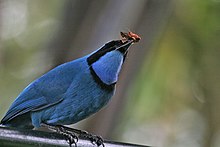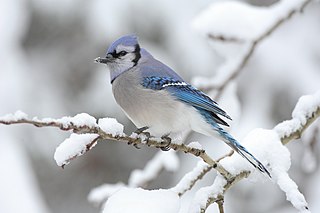
Corvidae is a cosmopolitan family of oscine passerine birds that contains the crows, ravens, rooks, magpies, jackdaws, jays, treepies, choughs, and nutcrackers. In colloquial English, they are known as the crow family or corvids. Currently, 139 species are included in this family. The genus Corvus containing 50 species makes up over a third of the entire family. Corvids (ravens) are the largest passerines.

Cyanocorax is a genus of New World jays, passerine birds in the family Corvidae. It contains several closely related species that primarily are found in wooded habitats, chiefly in lowland tropical rainforest but in some cases also in seasonally dry forest, grassland and montane forest. They occur from Mexico through Central into southern South America, with the green jay and brown jay just entering the United States in southernmost Texas, ad the Azure and Plush-crested jays occurring southwards to the lower Paraná River basin. This genus is considered especially close to Cyanolyca, an upland radiation occurring throughout the American Cordillera from Mexico to Peru and Bolivia, who look very similar to the blue-and-black species of Cyanocorax except for being a bit smaller. The North American blue jay genera Aphelocoma, Cyanocitta and Gymnorhinus seem to be slightly less closely related.

The collared trogon is a near passerine bird in family Trogonidae, the quetzals and trogons. It is found in Mexico, throughout Central America, and in northern South America.
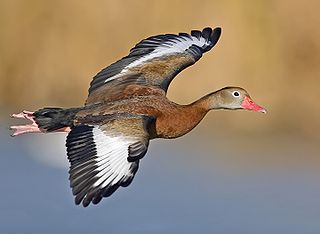
The black-bellied whistling duck, formerly called the black-bellied tree duck, is a whistling duck that before 2000 bred mainly in the southernmost United States, Mexico, and tropical Central to south-central South America. It can be found year-round in much of the United States. It has been recorded in every eastern state and adjacent Canadian province. Since it is one of only two whistling duck species native to North America, it is occasionally just known as the "whistling duck" or "Mexican squealer" in the southern USA.

The black-collared jay is a jay found in Andean forests in Ecuador, Colombia and Venezuela. It was formerly considered conspecific with the white-collared jay.

The bronzed cowbird, once known as the red-eyed cowbird, is a small icterid.

The black phoebe is a passerine bird in the tyrant-flycatcher family. It breeds from southwest Oregon and California south through Central and South America. It occurs year-round throughout most of its range and migrates less than the other birds in its genus, though its northern populations are partially migratory. Six subspecies are commonly recognized, although two are occasionally combined as a separate species, the white-winged phoebe.

The solitary eagle or montane solitary eagle is a large Neotropical eagle. It is also known as the black solitary eagle.
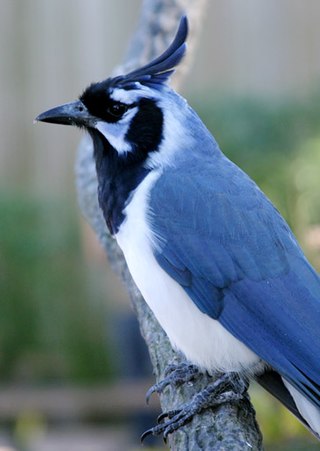
The black-throated magpie-jay is a strikingly long-tailed magpie-jay of northwestern Mexico.

The azure-hooded jay is a species of bird in the family Corvidae. It is found in Middle America. Its natural habitat is subtropical or tropical moist montane forest. This species is known to have four subspecies. It is 11 to 12 inches in length and is dark blue with a black head and upper chest. The back of the head and neck are sky blue with a white border.

The white-throated jay, also known as the Omiltemi jay, is a species of bird in the family Corvidae. It is endemic to the Sierra Madre del Sur ranges of Mexico.

The dwarf jay is a species of bird in the family Corvidae. It is endemic to Mexico. Its natural habitat is subtropical or tropical moist montane forests, specifically comprising an oak-pine mix. As its name would imply, this is the smallest member of the family Corvidae at 20–23 cm long and weighing 41 g. It is threatened by habitat loss.
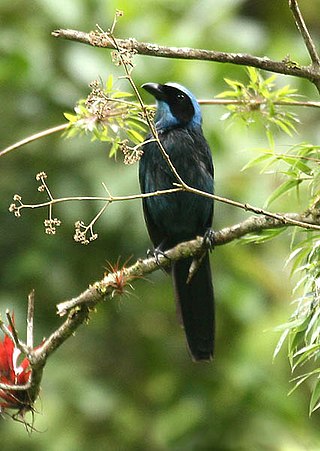
The beautiful jay is a species of bird in the crow and jay family Corvidae. It is closely related to the azure-hooded jay, and the two species are considered sister species. The species is monotypic, having no subspecies. The specific name for the beautiful jay, pulchra, is Latin for "beautiful".
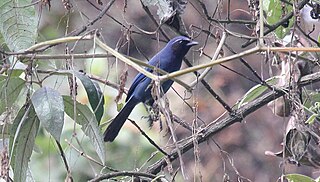
The black-throated jay is a species of bird in the family Corvidae. It is found in Chiapas, Guatemala and Honduras. Its natural habitat is subtropical or tropical moist montane forests.

The turquoise jay is a species of bird in the family Corvidae.

The white-collared jay is a species of bird in the family Corvidae. It is found in Andean forests in Peru and Bolivia. It was formerly considered conspecific with the black-collared jay. The white-collared jay was classified as least concern in 1988 and as near threatened in 2012.

The Benito Juárez National Park is in the Valles Centrales Region of Oaxaca, Mexico, and includes parts of the municipalities of San Felipe Tejalapam and San Andres Huayapan. The southern boundary of the park is about five kilometers north of the City of Oaxaca. The park was established in 1937 during the presidency of General Lazaro Cardenas del Rio, and is named after President Benito Juárez, who was a native of Oaxaca.

The common black hawk is a bird of prey in the family Accipitridae, which also includes the eagles, hawks, and vultures.
Omiltemi Ecological State Park is a protected area in southern Mexico. It is located in the Sierra Madre del Sur of Guerrero. The park includes well-preserved pine–oak forests and cloud forests.
